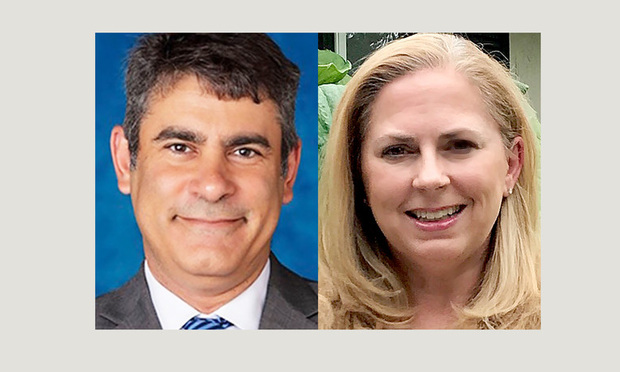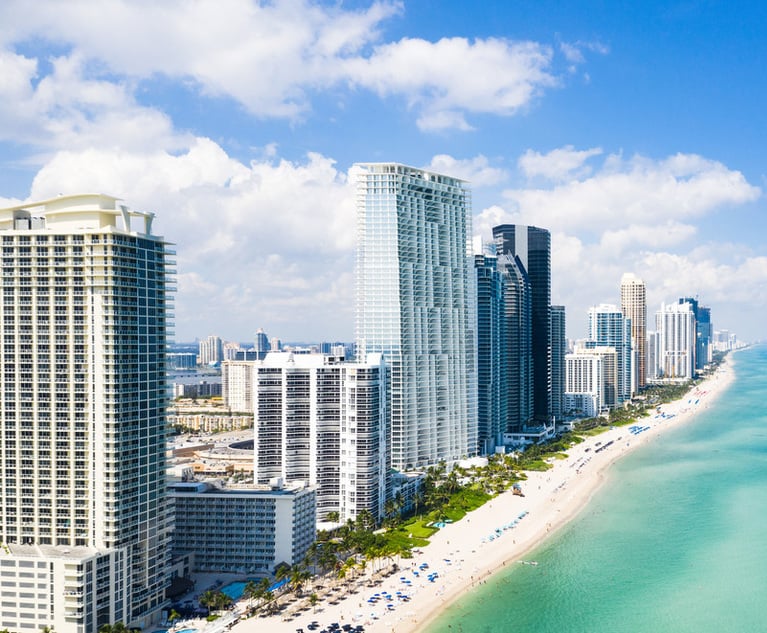Miami Team Helps Piece Together 'El Chapo' Conviction
Joaquin "El Chapo" Guzman's bad reputation isn't enough to warrant a criminal conviction. Miami federal prosecutors helped piece together the evidence to support guilty verdicts and a life sentence.
December 09, 2019 at 06:00 AM
3 minute read
 Fridman Fels & Soto co-founder Adam Fels and Lynn Kirkpatrick, U.S. Attorney's Office, Miami Fl. Courtesy photos
Fridman Fels & Soto co-founder Adam Fels and Lynn Kirkpatrick, U.S. Attorney's Office, Miami Fl. Courtesy photos
CRIMINAL LAW
Adam Fels, Andrea Goldbarg and Lynn Kirkpatrick
U.S. Attorney's Office
Joaquin "El Chapo" Guzman's reputation preceded him when he was extradited by Mexico to the United States. His exploits as a leader of the Sinaloa Cartel were dramatized in the Netflix series with his nickname as the title.
Guzman was reputed to be the biggest smuggler of drugs into the United States, and he faced federal indictments by New York and Miami grand juries detailing his criminal history. But to gain a conviction, prosecutors needed to move beyond the myths and present facts in the New York trial to tie Guzman to smuggled drugs.
Two witnesses independently put Guzman on a 10-year-old phone call to arrange a Chicago-area heroin delivery. This is the kind of detail needed to implicate Guzman.
Miami prosecutors Adam Fels, now with Fridman Fels & Soto, Andrea Goldbarg and Lynn Kirkpatrick helped assemble the case that resulted in conviction and a life sentence plus a $12.6 billion forfeiture.
Describe a key piece of testimony, evidence, ruling or order in the case and your view of how it influenced the outcome.
We gave the opening statements for the trial on Nov. 13, 2018. Precisely a decade earlier on Nov. 13, 2008, DEA special agents and task force officers covered the pickup of 20 kilograms of heroin in a Chicago-area Home Depot parking lot. The intended recipient was a government cooperator named Pedro Flores. He recorded two calls with Guzman in which Flores agreed to provide $1 million to Guzman's people in Chicago. Guzman placed another man on the phone — whose voice Flores didn't recognize — and this man gave Flores a phone number and asked him to speak with "Lazaro."
A few months before trial, we interviewed a witness named Alex Cifuentes, who lived with Guzman in 2008. We asked him to talk about the people who used to pick up money in the U.S. He ticked off a short list, but when he mentioned "Lazaro," I pulled out my laptop, played him the call between Flores, Guzman and the mystery man, and asked if he recognized the latter. Cifuentes listened and then replied: "That's me."
Of the three people on the call, one was the defendant, and the other two were government witnesses who did not know each other and had never met.
This content has been archived. It is available through our partners, LexisNexis® and Bloomberg Law.
To view this content, please continue to their sites.
Not a Lexis Subscriber?
Subscribe Now
Not a Bloomberg Law Subscriber?
Subscribe Now
NOT FOR REPRINT
© 2025 ALM Global, LLC, All Rights Reserved. Request academic re-use from www.copyright.com. All other uses, submit a request to [email protected]. For more information visit Asset & Logo Licensing.
You Might Like
View All
Winston & Strawn Snags Sidley Austin Cross-Border Transactions Partner in Miami
2 minute read
Miami’s Arbitration Week Aims To Cement City’s Status as Dispute Destination
3 minute read
Brazil Is Quickly Becoming a Vital LatAm Market for Greenberg Traurig, Other US Law Firms
5 minute readTrending Stories
- 1States Reach New $7.4B Opioid Deal With Purdue After SCOTUS Ruling
- 2$975,000 Settlement Reached After Fall on Sidewalk
- 3'Where Were the Lawyers?' Judge Blocks Trump's Birthright Citizenship Order
- 4Big Law Sidelined as Asian IPOs in New York Are Dominated by Small Cap Listings
- 5Netflix Music Guru Becomes First GC of Startup Helping Independent Artists Monetize Catalogs
Who Got The Work
J. Brugh Lower of Gibbons has entered an appearance for industrial equipment supplier Devco Corporation in a pending trademark infringement lawsuit. The suit, accusing the defendant of selling knock-off Graco products, was filed Dec. 18 in New Jersey District Court by Rivkin Radler on behalf of Graco Inc. and Graco Minnesota. The case, assigned to U.S. District Judge Zahid N. Quraishi, is 3:24-cv-11294, Graco Inc. et al v. Devco Corporation.
Who Got The Work
Rebecca Maller-Stein and Kent A. Yalowitz of Arnold & Porter Kaye Scholer have entered their appearances for Hanaco Venture Capital and its executives, Lior Prosor and David Frankel, in a pending securities lawsuit. The action, filed on Dec. 24 in New York Southern District Court by Zell, Aron & Co. on behalf of Goldeneye Advisors, accuses the defendants of negligently and fraudulently managing the plaintiff's $1 million investment. The case, assigned to U.S. District Judge Vernon S. Broderick, is 1:24-cv-09918, Goldeneye Advisors, LLC v. Hanaco Venture Capital, Ltd. et al.
Who Got The Work
Attorneys from A&O Shearman has stepped in as defense counsel for Toronto-Dominion Bank and other defendants in a pending securities class action. The suit, filed Dec. 11 in New York Southern District Court by Bleichmar Fonti & Auld, accuses the defendants of concealing the bank's 'pervasive' deficiencies in regards to its compliance with the Bank Secrecy Act and the quality of its anti-money laundering controls. The case, assigned to U.S. District Judge Arun Subramanian, is 1:24-cv-09445, Gonzalez v. The Toronto-Dominion Bank et al.
Who Got The Work
Crown Castle International, a Pennsylvania company providing shared communications infrastructure, has turned to Luke D. Wolf of Gordon Rees Scully Mansukhani to fend off a pending breach-of-contract lawsuit. The court action, filed Nov. 25 in Michigan Eastern District Court by Hooper Hathaway PC on behalf of The Town Residences LLC, accuses Crown Castle of failing to transfer approximately $30,000 in utility payments from T-Mobile in breach of a roof-top lease and assignment agreement. The case, assigned to U.S. District Judge Susan K. Declercq, is 2:24-cv-13131, The Town Residences LLC v. T-Mobile US, Inc. et al.
Who Got The Work
Wilfred P. Coronato and Daniel M. Schwartz of McCarter & English have stepped in as defense counsel to Electrolux Home Products Inc. in a pending product liability lawsuit. The court action, filed Nov. 26 in New York Eastern District Court by Poulos Lopiccolo PC and Nagel Rice LLP on behalf of David Stern, alleges that the defendant's refrigerators’ drawers and shelving repeatedly break and fall apart within months after purchase. The case, assigned to U.S. District Judge Joan M. Azrack, is 2:24-cv-08204, Stern v. Electrolux Home Products, Inc.
Featured Firms
Law Offices of Gary Martin Hays & Associates, P.C.
(470) 294-1674
Law Offices of Mark E. Salomone
(857) 444-6468
Smith & Hassler
(713) 739-1250







